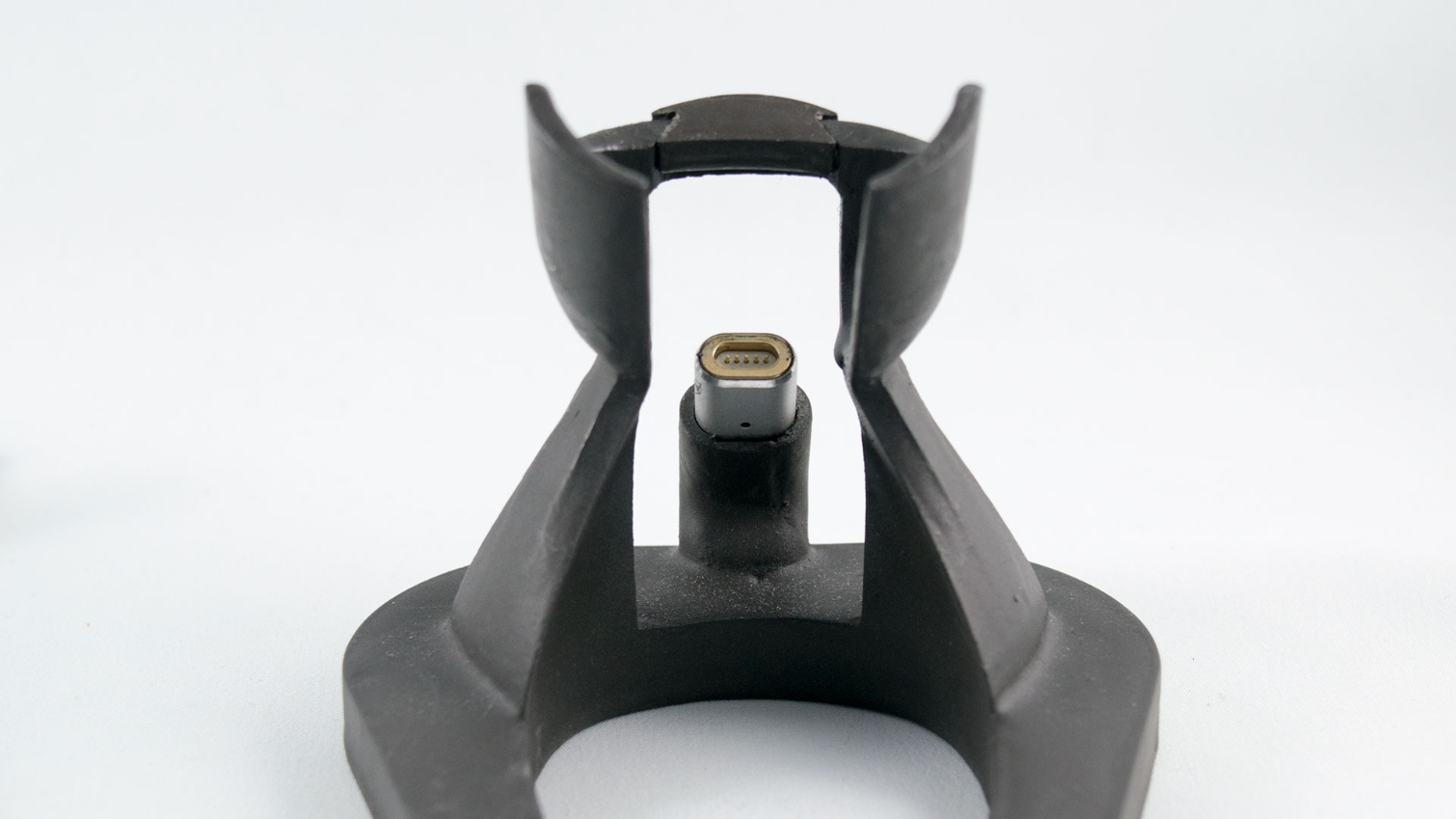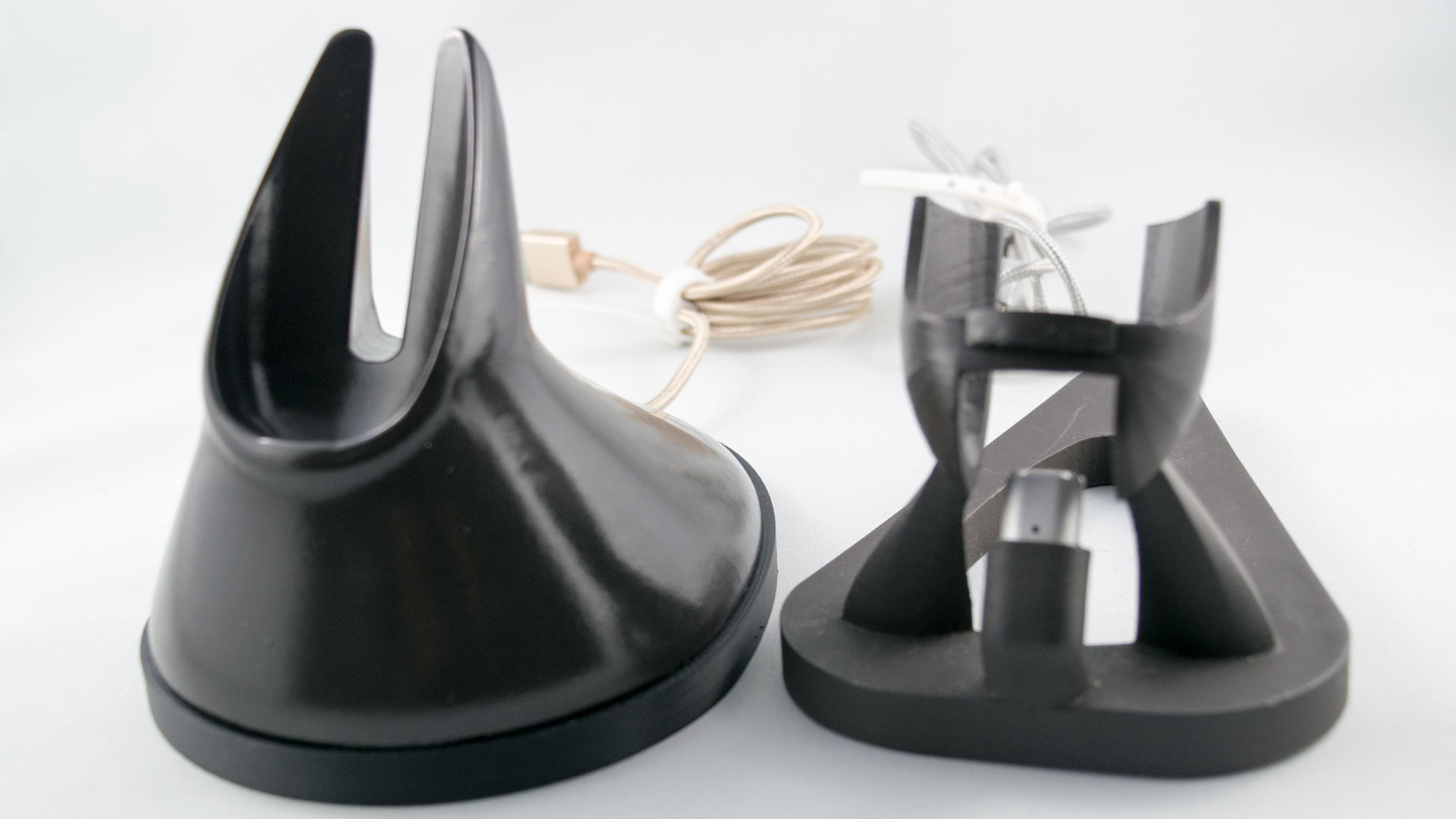VR Mag Docks Are Elegant, Convenient, And A Worthy Accessory For Vive Owners
VR Mag Docks are clever stands that allow you to put your Vive controllers on display while you charge them, and a convenient way to take them off the charger when it’s time to play.
As the virtual reality hardware market matures, the demand for accessories will undoubtedly grow with it. If you look at the selection of aftermarket accessories for the console market, for example, you’ll find third-party controllers, chargers, cooling systems, protective covers for controllers, and so on. We expect that the VR accessories market will mimic the console market in many ways.
A Nascent Market
The accessories market for VR hardware is just getting started. You can get your hands on a few third-party accessories, but not many. VR Cover offers a range of face cushion covers and replacements; VR Lens Lab makes lens protectors and prescription lens upgrades; Hyperkin offers a range of rubberized protective sleeves for Vive controllers and headsets; and multiple companies offer chargingdocks/headset stands for the PSVR and Move controllers.
I’ve certainly missed a few, but the point is, the VR accessories market is sparse right now, which makes it the perfect time for new companies and entrepreneurs to capture significant market share.
Dylan Evans of Manchester, England, is one such entrepreneur hoping to get an early foothold on the market. Earlier this year, Evans created and released a printable 3D model of a Vive controller stand into which you could insert a magnetic USB cable. Evans received feedback from people who printed their own stands, which he used to improve the design and release as a saleable product.







Evans launched his company and product, VR Mag Docks, in July 2016. After spotting the announcement, I reached out him to inquire about a review sample. Evans quickly agreed to send a set of docks but noted that the response to the announcement overwhelmed his capacity to produce the docks. The following month, though, he pulled the docks due to a design flaw and set out to reimagine their construction.
“I have learned a lot over the few orders I have made," said Evans. "The docks you will receive are relatively complex in terms of plastic parts. This makes them unique and interesting but has several disadvantages, chief among them, that it is very time consuming to get a 'perfect' finish (if you look closely at your docks you will see the finish is not perfect), and it will be very difficult to scale the business should it take off. In addition to this, the current design is not repairable. I use high-quality cables but things break, and I want overseas buyers to be able to fix their purchase.”
Get Tom's Hardware's best news and in-depth reviews, straight to your inbox.
Evans halted production of the VR Mag Docks on August 14 with a notice indicating that sales would resume when he finalized the new design, which he said would take “several weeks” and would launch “in conjunction with a new wall holder” product. Several weeks turned into a little more than two months, and the wall holders are still a work in progress, but Evans relaunched the VR Mag Docks at the end of October with a completely new design.


Refined Design
The second-generation VR Mag Docks are still 3D printed, but the structure of the latest version is far less complex. The first-generation VR Mag Docks featured solid internal construction with the magnetic cable embedded directly into the plastic, which made it impossible to replace the cable should it ever fail. The reimagined docks feature a removable bottom plate so you can change the cable if necessary. The magnetic end is glued in with standard hot glue.
The magnetic cables include tiny USB dongles with magnetic contacts that plug into the charge ports on your controllers. The charge port on the Vive controller is slightly recessed, so the magnetic USB dongle is hard to pull out once you stick it in. Fortunately, you’ll rarely have to remove it. Evans said he uses “high-quality” cables that are capable of doing firmware updates.
If you must remove the USB dongle, don’t use tweezers or pliers. Some early adopters reported that their adapters broke apart, and leaving the USB port plugged in. I’ve found that sticking your fingernail between the plug and the controller forces it out without damaging anything.
The updated VR Mag Dock charging bases are much larger than the previous version. They stand approximately 95mm tall, which is 25mm taller than the older model. The oblong base of the new design takes more surface area than the old stands, too.
The cradles for the controller also sit at a different angle. In the first version, the controllers rest at close to a 45-degree angle from the base. In the new base stations, the controllers sit more upright. Generally, the cradles were redesigned. The previous iteration was clever; it featured a slot for the hand strap and was designed to let you easily drop the controller into place. With the new dock, you can still quickly drop your controller into the dock, but it also lets you grab the controller with less hassle when you need it.
Dropping your controller into the dock couldn’t be easier. The tapered nature of the bottom of the Vive wand allows the controller to slip into the slot to exactly where it needs to be. You don’t have to worry about being precise. Just get the controller into the slot and let go. Picking up the controller is just as painless if you do it right.
It's All About The Technique
The new docks feel somewhat lighter than the previous version, but that’s an illusion due to the balance of each design. The first edition weighs 141 grams, but most of its weight is at the base, and almost none is in the brace that holds the controller. The redesigned docks weigh 160 grams and have more even weight distribution.
Despite the extra weight, the magnets will accidentally lift the docks briefly. In my experience, the dock lifts off the table with the controller if you try to lift the controller upwards. The magnets aren’t strong enough to sustain the dock’s weight, but they are strong enough to displace the mag dock.
To avoid lifting the base when you grab your controller, pull the controller away from the dock as if you’re pulling back on a joystick. You won’t damage the magnetic attachment by pulling it away at an angle. It doesn’t take long to get used to flicking your wrist back slightly while you pull the controller back to break the magnetic attachment.
Available Now
If you use your Vive a lot, especially if you habitually show it to friends or at tradeshows, these magnetic docks are incredibly handy to keep the charge going between turns without risking damage to your USB ports and the hassle of plugging the cord in regularly.
VR Mag Docks is based in Manchester, England, and therefore it offers the docks in British pounds. A set of two docks with magnetic USB cables goes for £39.99 (approximately $49 USD) plus shipping to your respective region. Each set of docks is made to order, and VR Mag Docks offers customization. If you want something unique, contact sales@vrmagdocks.com before placing an order.
Kevin Carbotte is a contributing writer for Tom's Hardware who primarily covers VR and AR hardware. He has been writing for us for more than four years.
-
jasonelmore Yeah but how many tablets have a removable battery? That would probably add a lot of weight and costs to make it external.Reply
Remember nintendo, if you dont put a good battery in the switch, you could end up like samsung and the note 7




